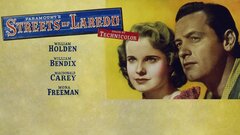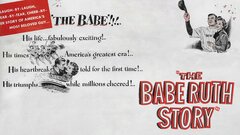A burly New York City native who specialized in playing all manner of lugs, both loveable and dangerous, William Bendix achieved a level of popularity that was almost unheard of for a character actor who proclaimed himself to be "about as handsome as a mud fence." After performing in some unsuccessful plays, he first gained significant notice in the Broadway smash "The Time of Your Life" (1939-1940). That soon led to a movie career, with Bendix appearing in everything from comedies like "Woman of the Year" (1942) and "Who Done It?" (1942), to World War II actioners and thrillers like "The Glass Key" (1942) and Alfred Hitchcock's "Lifeboat" (1944).
Bendix's blustery delivery and enduring likeability found a perfect vehicle in the comedy "The Life of Riley," first on radio (ABC/NBC, 1944-1951), then as a 1949 motion picture and, finally, a long-running television series (NBC, 1953-58). Loveable lunkhead Chester A. Riley was the role for which he was best remembered and while the show's formula was mostly set in stone, Bendix's talent helped to keep it fresh and amusing.
As was customary with actors who sported something less than matinee idol looks, Bendix was largely restricted to playing certain types of characters, but few did as memorable a job on such a consistent basis, and he ranked as one of TV's archetypal patriarchs.
William Bendix was born on Jan. 14, 1906 in New York City and would be associated with the Big Apple throughout his career. Bendix first tried acting at age 16 for the Henry Street Settlement House Players, but soon adopted 9-to-5 work, including a stint as a singing waiter. His family opened a grocery store in Orange, NJ, where he was employed as manager for a time. A baseball fan, he also served as a batboy for both the New York Yankees and their crosstown rivals, The New York Giants back in the days when they shared the same stadium.
The sport would figure into his later vocation as an actor, which did not begin in earnest until Bendix was in his thirties and a participant in the New Jersey Federal Theater Project. Additional acting assignments followed in several Theater Guild plays. Bendix made his Broadway bow in the drama "The Trial of Dr. Beck" (1937), which came and went with little notice. His subsequent Great White Way plays, "Run Sheep Run" (1938) and "Miss Swan Expects" (1939), were similarly short-lived, but did showcase Bendix's comedic talents, which finally received wide stage exposure when he portrayed Krupp the cop in the Pulitzer Prize-winning hit "The Time of Your Life" (1939-1940), which enjoyed a year-long engagement and also went on the road.
The notoriety Bendix earned from "The Time of Your Life" led to movie roles and he appeared in "Woman of the Year" (1942), the first of nine motion pictures that teamed Spencer Tracy and Katherine Hepburn, and the World War II drama "Wake Island" (1942), which earned him his only Oscar nomination. He effectively menaced Alan Ladd in the superb film noir "The Glass Key" (1942), was a foil for Abbott & Costello in "Who Done It?" (1942), and played a seaman in Alfred Hitchcock's classic thriller "Lifeboat" (1944).
That year, Bendix also began a long run on radio with the comedy "The Life of Riley" (ABC/NBC, 1944-1951). As perpetually befuddled aircraft factory worker Chester A. Riley, Bendix was the perfect choice to play a lug with a heart of gold and the character's oft-repeated frustration "What a revoltin' development this is!" soon entered the popular lexicon. Audiences would actually see Bendix as Riley a few years later, but even before that, the actor had clearly found his signature part.
On the silver screen, Bendix continued to alternate between genres, co-starring in comedies like "It's in the Bag!" (1945), the drama "A Bell for Adano" (1945), and the film noir thrillers "The Dark Corner" (1946) and "The Blue Dahlia" (1946). He also graced the movie version of "The Time of Your Life" (1948), playing saloon owner Nick this time, while fellow character player Broderick Crawford took the role of Krupp.
Bendix was employed as a batboy during the time when Babe Ruth was the reigning king of baseball and no doubt seemed like an ideal choice to play the "The Great Bambino" in "The Babe Ruth Story" (1948). Unfortunately, the resulting film was a rushed and sappy misfire that bore little resemblance to the facts and, in later years, Bendix had little positive to say about his interpretation of the baseball legend.
Bendix quickly rebounded from the disappointment of "The Babe Ruth Story" with an uncharacteristic period role as Sir Sagramore in the Bing Crosby musical-fantasy farce "A Connecticut Yankee in King Arthur's Court" (1949). The actor's big credit that year, however, was a motion picture incarnation of "The Life of Riley" (1949). The film's popularity resulted in a like-named TV spin-off (NBC, 1949-1950), produced without Bendix, who was unable to sign on.
Jackie Gleason took over the title character, but the early sitcom failed to strike a chord with viewers and lasted only one season. "The Life of Riley" may have failed as a television series, but the public still adored both the character and Bendix. In 1950, he and the rest of the show's cast performed a live radio broadcast before 12,000 appreciative fans at the Milwaukee Arena.
A better film revolving around the Great American Pastime, "Kill the Umpire" (1950) provided the actor with a fine comedic outing as an obsessed baseball fan who finds out what life is like on the other side of the fence when he is forced to work as an umpire. In a supporting capacity, Bendix did well alongside Kirk Douglas in the fine police procedural "Detective Story" (1951) and held his own against the blustery Robert Newton, shivering each and every one of his timbers as "Blackbeard, the Pirate" (1952).
In 1953, a new TV incarnation of "The Life of Riley" (NBC, 1953-58) was mounted with Bendix back in the lead. The show quickly found the audience its predecessor had struggled to reach. The family-oriented program went on to enjoy a five-year run and as partial owner of the property, Bendix benefited financially from its additional later success in syndication.
In between his small screen obligations, Bendix continued to grace features like the 3-D thriller "Dangerous Mission" (1954) and "Crashout" (1955), in which he masterminded a prison break. A stomach ulcer operation in 1955 slowed him down briefly, but Bendix was soon back in characteristic fare like the World War II thrillers "Battle Stations" (1956) and "The Deep Six" (1958). He received a star on the Hollywood Walk of Fame and made a one shot return to Broadway as the replacement once again for Jackie Gleason in the musical comedy "Take Me Along" (1959-1960).
The actor even ventured into the world of children's records with the 1959 LP William Bendix Sings and Tells Famous Pirate Stories. The cover memorably featured him in Captain Hook-style garb, complete with peg leg. Bendix was back on series television as the star of "Overland Trail" (NBC, 1960), but the Western did not stand out enough amongst the reams of similar network TV offerings.
Additional silver screen assignments came via prominent parts in lesser efforts like "Johnny Nobody" (1961) and the German military comedy "The Phony American" (1961), but he also dedicated much time to stage work, appearing in the national touring company of "Never Too Late" and productions of "The Gazebo" and Moss Hart's "Light Up the Sky." The big budget comedies "Boys Night Out" (1962) and "For Love or Money" (1963) also made good use of Bendix in smaller but effective roles.
Bendix had his final film credits in producer A.C. Lyles' "The Young and the Brave" (1963), "Law of the Lawless" (1964) and "Young Fury" (1965). The latter two were among Lyles' so-called "Geezer Westerns," a series of small-scale oaters peopled with elderly veterans beloved by fans of the genre. In the years following his ulcer procedure, Bendix's health was variable and reportedly cost him a new series at CBS.
In response, he sued the network and received an out-of-court settlement. Sometime after finishing "Young Fury," Bendix was hospitalized. In addition to his stomach problems, which brought about a case of malnutrition, he developed lobar pneumonia and died on Dec. 14, 1964, leaving behind a rich history of stellar character performances.
By John Charles









































































































































































































































